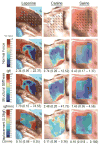Automated Indentation Mapping of Vocal Fold Structure and Cover Properties Across Species
- PMID: 30408175
- PMCID: PMC6320270
- DOI: 10.1002/lary.27341
Automated Indentation Mapping of Vocal Fold Structure and Cover Properties Across Species
Abstract
Objectives/hypothesis: Various animal models have been employed to investigate vocal fold (VF) and phonatory function. However, biomechanical testing techniques to characterize vocal fold structural properties vary and have not compared critical properties across species. We adapted a nondestructive, automated indentation mapping technique to simultaneously quantify VF structural properties (VF cover layer and intact VF) in commonly used species based on the hypothesis that VF biomechanical properties are largely preserved across species.
Study design: Ex vivo animal model.
Methods: Canine, leporine, and swine larynges (n = 4 each) were sagittally bisected, measured, and subjected to normal indentation mapping (indentation at 0.3 mm; 1.2 mm/s) with a 2-mm spherical indenter to quantify normal force along the VF cover layer, structural stiffness, and displacement at 0.8 mN; two-dimensional maps of the free VF edge through the conus elasticus were created for these characterizations.
Results: Structural stiffness was 7.79 gf/mm (0.15-74.55) for leporine, 2.48 gf/mm (0.20-41.75) for canine, and 1.45 gf (0.56-4.56) for swine. For each species, the lowest values were along the free VF edge (mean ± standard deviation; leporine: 0.40 ± 0.21 gf/mm, canine: 1.14 ± 0.49 gf/mm, swine: 0.89 ± 0.28 gf/mm). Similar results were obtained for the cover layer normal force at 0.3 mm. On the free VF edge, mean (standard deviation) displacement at 0.08 gf was 0.14 mm (0.05) in leporine, 0.11 mm (0.03) in canine, and 0.10 mm (0.02) in swine.
Conclusions: Automated indentation mapping yielded reproducible biomechanical property measurement of the VF cover and intact VF. Divergent VF structural properties across canine, swine, and leporine species were observed.
Level of evidence: NA Laryngoscope, 129:E26-E31, 2019.
Keywords: Larynx; indentation; mechanical testing; structural stiffness; vocal fold; voice.
© 2018 The American Laryngological, Rhinological and Otological Society, Inc.
Conflict of interest statement
The authors have no conflicts of interest or financial disclosures.
Figures





Similar articles
-
Young's modulus of canine vocal fold cover layers.J Voice. 2014 Jul;28(4):406-10. doi: 10.1016/j.jvoice.2013.12.003. Epub 2014 Feb 1. J Voice. 2014. PMID: 24491497 Free PMC article.
-
Dynamic nanomechanical analysis of the vocal fold structure in excised larynges.Laryngoscope. 2017 Jul;127(7):E225-E230. doi: 10.1002/lary.26410. Epub 2016 Nov 22. Laryngoscope. 2017. PMID: 27873325 Free PMC article.
-
Measurement of Young's modulus of vocal folds by indentation.J Voice. 2011 Jan;25(1):1-7. doi: 10.1016/j.jvoice.2009.09.005. Epub 2010 Feb 19. J Voice. 2011. PMID: 20171829 Free PMC article.
-
Functional assessment of the ex vivo vocal folds through biomechanical testing: A review.Mater Sci Eng C Mater Biol Appl. 2016 Jul 1;64:444-453. doi: 10.1016/j.msec.2016.04.018. Epub 2016 Apr 8. Mater Sci Eng C Mater Biol Appl. 2016. PMID: 27127075 Free PMC article. Review.
-
Mechanical characterization of vocal fold tissue: a review study.J Voice. 2014 Nov;28(6):657-67. doi: 10.1016/j.jvoice.2014.03.001. Epub 2014 Jul 5. J Voice. 2014. PMID: 25008382 Review.
Cited by
-
Effect of continuous local dexamethasone on tissue biomechanics and histology after inhalational burn in a preclinical model.Laryngoscope Investig Otolaryngol. 2023 Jun 26;8(4):939-945. doi: 10.1002/lio2.1093. eCollection 2023 Aug. Laryngoscope Investig Otolaryngol. 2023. PMID: 37621281 Free PMC article.
-
Augmentation and vocal fold biomechanics in a recurrent laryngeal nerve injury model.Laryngoscope Investig Otolaryngol. 2022 Jul 6;7(4):1057-1064. doi: 10.1002/lio2.853. eCollection 2022 Aug. Laryngoscope Investig Otolaryngol. 2022. PMID: 36000036 Free PMC article.
-
Comparison of Aerodynamic and Elastic Properties in Tissue and Synthetic Models of Vocal Fold Vibrations.Bioengineering (Basel). 2024 Aug 15;11(8):834. doi: 10.3390/bioengineering11080834. Bioengineering (Basel). 2024. PMID: 39199792 Free PMC article.
-
Infraglottal Medialization: Increasing Vocal Fold Stiffness Gradient for Improved Vocal Efficiency.J Voice. 2024 Dec 9:S0892-1997(24)00389-8. doi: 10.1016/j.jvoice.2024.11.010. Online ahead of print. J Voice. 2024. PMID: 39658427
-
Localized delivery of therapeutics impact laryngeal mechanics, local inflammatory response, and respiratory microbiome following upper airway intubation injury in swine.Respir Res. 2024 Sep 28;25(1):351. doi: 10.1186/s12931-024-02973-1. Respir Res. 2024. PMID: 39342180 Free PMC article.
References
Publication types
MeSH terms
Grants and funding
LinkOut - more resources
Full Text Sources
Research Materials

